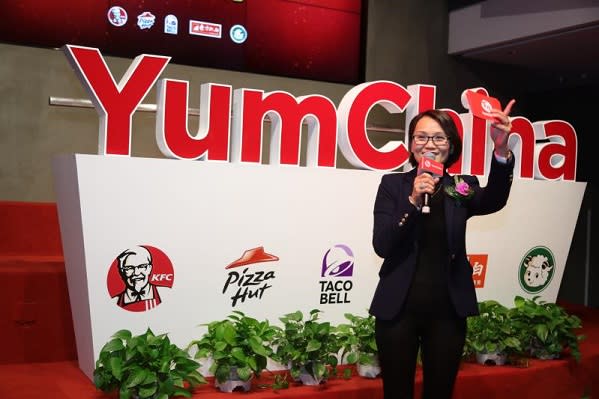3 Things Yum China's Management Wants You to Know
After a bummer 2018, Yum China (NYSE: YUMC) -- the sole licensee of KFC and Pizza Hut in the world's most populous country -- is on the mend. Shares have rallied back near the all-time highs they reached in early 2018 when the licensee was barely a year past its separation from former parent Yum! Brands (NYSE: YUM). A better-than-feared conclusion to 2018 helped, as has optimism that the trade war between the U.S. and China may be coming to an end.
Looking beyond the immediate catalysts moving the stock, though, Yum holds the pole position in China as the country's largest restaurant operator and has a lot of space in front of it to keep expanding. At its 2019 investor conference, Yum China's top team talked strategy -- including more stores, digital and delivery, and an elusive turnaround for Pizza Hut.
A new way to expand
Since gaining independence as its own company a few years ago, Yum China has been aggressively opening new stores. With a total of 8,484 locations at the end of 2018, the multibrand chain is already the country's largest. However, this doesn't mean it has hit the ceiling.
That's because China is still a rapidly developing country -- fears of an economic slowdown notwithstanding. China's restaurant industry is expected to grow 8% a year through 2023. For the sake of comparison, it's pegged at a 3%- and 2%-a-year rate in the U.S. and European Union, respectively, over the same time period. Plus, Yum says there are only 5.8 KFC and Pizza Hut stores per million people in China. In the U.S., it's 35.5 KFCs and Pizza Huts per million potential consumers.
With the middle class across the Pacific getting hungrier, Yum is making a push for 10,000 total stores by the year 2021. That excludes openings of its new stand-alone coffee brand COFFii & JOY (more on that in a minute). To help, new agreements were signed with energy companies Sinopec (NYSE: SNP) and China National Petroleum to put more than 100 KFCs and Pizza Huts in gas stations across the country. The two energy companies collectively operate more than 50,000 gas stations in China, so if the partnership works out, it could go a long way toward helping Yum reach its longer-term goal of 20,000 total restaurants.
Artificially intelligent fast food?
Bombarding Asia with fried chicken and pizza is only part of the strategy here. Digital and delivery have also been key components of Yum's growth, as indicated by the 160 million KFC and 50 million Pizza Hut Rewards members. Use of apps and other digital tools to order and get food delivered is much more prevalent in China than it is stateside.
The push for more digital members and ordering convenience will continue. To that end, a new artificial intelligence-powered KFC app is launching, delivering menu recommendations and other insights to hungry consumers on the go. Value-based digital ad campaigns will also begin rolling out for the lagging Pizza Hut. The same digital platform will help make both chains more efficient, optimizing delivery services based on need in any given area.
CEO Joey Wat had this to say:
The rapid adoption of digital and delivery technologies has had a transformative impact on the restaurant industry over the past five years. This is creating significant opportunities to improve our operations and build stronger connections with our customers. We are excited by this trend and are embracing innovation throughout every area of our business to power our growth. We look forward to continuing to push the boundaries of technology and implement more innovations to enhance efficiency and create more unique and exciting dining experiences for our customers while generating strong returns for our shareholders.

CEO Joey Wat. Image source: Yum China.
Pizza, coffee, and delivery
One of the pain points for Yum China in recent years has been Pizza Hut. To date, menu changes, remodels, and digital selling haven't helped the chain turn a corner -- at least not yet. Newer stores and store upgrades have shown promise, though, so the company is accelerating the process to remodel all of them by 2021.
Only time will tell if Chinese diners will love the Hut again, but Yum isn't going to wait and see. If you hadn't heard, coffee is all the rage these days, and China is no exception. Rather than let American brands like Starbucks (NASDAQ: SBUX) have all the fun, Yum sold 90 million cups of freshly ground coffee at KFC in 2018. That's significant, as 84% of coffee consumed in China is of the instant variety. However, with coffee shop sales expected to grow 11% a year through 2022, a new stand-alone chain was launched: COFFii & JOY. Less than a year after initial introduction, there are 13 locations in four cities.
COFFii & JOY could take some time to meaningfully add to financial results, but in the meantime, there's delivery. Adding the capability to more restaurants is an ongoing process but a worthwhile one. The delivery market is expected to grow 15% a year over the next few years, so the more locations that offer the convenience factor the better. Management also thinks it can contribute to more efficient and profitable operations overall, as the staffing needs and costs of delivery operations can be less than those of dine-in service.
There were no new earth-shattering announcements at Yum's 2019 investor conference, but it did add to proof that the opportunity ahead of the chain is still quite large. For those looking for a way to ride the wave of a developing middle class in China, Yum China's stock is one great way to do it.
More From The Motley Fool
Nicholas Rossolillo and his clients own shares of Yum China Holdings, Inc. The Motley Fool owns shares of and recommends Starbucks. The Motley Fool has a disclosure policy.

 Yahoo Finance
Yahoo Finance 